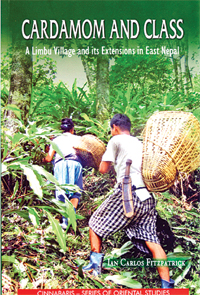A Limbu Village and Its Extensions in East Nepal
Ethnographic research in Nepal since the 1960s has resulted in a variety of books about the social, cultural, economic and political histories and contemporary situations of numerous caste and ethnic groups and communities. Many studies examine local circumstances within a wider context of national and international concerns. Some of the best of them deal with economic change, including the recent impact globalization, especially the opening of world markets to Nepalese products.
 Cardamom and Class by Ian Fitzpatrick sets a high standard among such studies. It focuses in considerable depth on the political economy of members of a Limbu ethnic community, and close economic relations with several caste groups that have settled amongst them. It provides a thorough review of the influences of a relatively new cash economy based on cardamom production and how it has stimulated wealth accumulation in ‘A Limbu Village and Its Extensions in East Nepal’ (the book’s subtitle).
Cardamom and Class by Ian Fitzpatrick sets a high standard among such studies. It focuses in considerable depth on the political economy of members of a Limbu ethnic community, and close economic relations with several caste groups that have settled amongst them. It provides a thorough review of the influences of a relatively new cash economy based on cardamom production and how it has stimulated wealth accumulation in ‘A Limbu Village and Its Extensions in East Nepal’ (the book’s subtitle).
Of most interest to non-anthropologist readers is the author’s rich description of the life and times of Mamangkhe village. He analyzes how economic opportunities beyond traditional subsistence farming have significantly altered villagers’ lives. It is, in general, a story played out in many Nepalese communities, involving the adoption of a cash crop (cardamom in this case, but tourism, military service, and remittance labor migration are analogous examples), and subsequent changes in local lifestyles and aspirations.
As a study of the ‘political economy’ of one community (and its extensions) Cardamom and Cash presents a fine example of how society creates wealth through the production and distribution of goods. The underlying direction of the book can be succinctly stated by saying that it is a political-economic study of how Mamangkhe village has changed over time, keyed to the rise of the cash crop economy combined with a variety of external forces. By so doing, the author emphasizes the importance of moving beyond an analysis of caste relations (of many past ethnographies) to the development of economic class distinctions in society.
The book has six chapters plus an Introduction and Conclusion. The chapters deal with the Theoretical Context, Historical Context, Mamangkhe Village, Cardamom, Migration, and Ecological and Socioeconomic Change. The author highlights each discussion with in-depth case studies of specific villagers both of Limbu ethnic and of Brahmin-Chhetri and Dalit caste identities.
In the History chapter the author traces changes in the local Limbu economy from early hunting and gathering to subsistence farming, then to major dependence on a single crop followed (for some villagers) by a relatively rapid accumulation of wealth (first from cardamom, later from remittances). These changes have led to dramatic changes in the structure of economic class relations within the community and (for some) to major out-migration and resettlement elsewhere.
The Migration chapter describes a situation common all across Nepal. Migration may be either temporary or permanent, and either national (internal) and international. Temporary forms of migration include moving for purposes of schooling and marketing, and for religious reasons (e.g., a pilgrimage). Permanent migration occurs for employment and, for some, for marriage purposes. The outside employment options include taking up government jobs elsewhere in the country (for a few) and foreign employment by many young people seeking significant earnings and remittances to increase household wealth. Migration away from the village to avoid the local impacts of the recent insurgency in Nepal has also been significant.
Permanent migration within Nepal has resulted in what some researchers call “dispersed settlements” well away from the original home community. Mamangkhe’s main dispersed settlement migration is to Jhapa District in the lower eastern Nepal hills and plains south of the original village.
Cardamom and Cash is a thoroughly engrossing read for academic and non-academic readers alike, and a significant contribution to the cumulative ethnography of Nepal.











